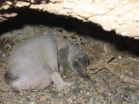(Press-News.org) A galaxy's core is a busy place, crowded with stars swarming around an enormous black hole. When galaxies collide, it gets even messier as the two black holes spiral toward each other, merging to make an even bigger gravitational monster.
Once it is created, the monster goes on a rampage. The merger kicks the black hole into surrounding stars. There it finds a hearty meal, shredding and swallowing stars at a rapid clip. According to new research by Nick Stone and Avi Loeb (Harvard-Smithsonian Center for Astrophysics), upcoming sky surveys might offer astronomers a way to catch a gorging black hole "in the act."
Before the merger, as the two black holes whirl around each other, they stir the galactic center like the blade of a blender. Their strong gravity warps space, sending out ripples known as gravitational waves. When the black holes merge, they emit gravitational waves more strongly in one direction. That inequality kicks the black hole in the opposite direction like a rocket engine.
"That kick is very important. It can shove the black hole toward stars that otherwise would have been at a safe distance," said Stone.
"Essentially, the black hole can go from starving to enjoying an all-you-can-eat buffet," he added.
When tidal forces rip a star apart, its remains will spiral around the black hole, smashing and rubbing together, heating up enough to shine in the ultraviolet or X-rays. The black hole will glow as brightly as an exploding star, or supernova, before gradually fading in a distinctive way.
Importantly, a wandering, supermassive black hole is expected to swallow many more stars than a black hole in an undisrupted galactic center. A stationary black hole disrupts one star every 100,000 years. In the best-case scenario, a wandering black hole could disrupt a star every decade. This would give astronomers a much better opportunity of spotting these events, particularly with new survey facilities like Pan-STARRS and the Large Synoptic Survey Telescope.
Catching the signal from a disrupted star is a good start. However, astronomers really want to combine that information with gravitational wave data from the black hole merger. The Laser Interferometer Space Antenna (LISA), a future mission designed to detect and study gravitational waves, could provide that data.
Gravitational wave measurements yield very accurate distances (to better than one part in a hundred, or 1 percent). However, they don't provide precise sky coordinates. A star's tidal disruption will let astronomers pinpoint the galaxy containing the recently merged black-hole binary.
By correlating the galaxy's redshift (a change in its light that's caused by the expanding universe) with an accurate distance, astronomers can infer the equation of state of dark energy. In other words, they can learn more about the force that's accelerating cosmic expansion, and which dominates the cosmic mass/energy budget today.
"Instead of 'standard candles' like supernovae, the black hole binary would be a 'standard siren.' Using it, we could create the most accurate cosmic 'ruler' possible," stated Loeb.
Finding a merged black hole also would allow theorists to explore a new regime of Einstein's general theory of relativity.
"We could test general relativity in the regime of strong gravity with unprecedented precision," said Loeb.
INFORMATION:
Newly merged black hole eagerly shreds stars
2011-04-09
ELSE PRESS RELEASES FROM THIS DATE:
Breast-cancer awareness now in national consciousness
2011-04-09
EUGENE, Ore. -- Each October, the color pink marks the arrival of National Breast Cancer Awareness Month. Media coverage, product promotions and even the football gridirons showcase the national effort to promote screenings and early detection of the cancer that 200,000 American women are diagnosed with each year.
New research from the University of Oregon examined more than 30 years of cancer registry data to determine if October events related to National Breast Cancer Awareness Months (NBCAM) lead to increases in breast cancer diagnoses in the following month of November. ...
Surveys confirm enormous value of science museums, 'free choice' learning
2011-04-09
CORVALLIS, Ore. – One of the first studies of its type has confirmed that a science museum can strongly influence the public's knowledge and attitudes about science and technology, and to a surprising degree can cut across racial, ethnic, educational and economic barriers.
The study focused on the California Science Center in Los Angeles, and offers profound support for the value of such institutions. It also reinforces the emerging concept of "free choice" learning, which holds that people get most of their knowledge about science from someplace other than school or ...
NYU Langone experts present advances at American Association of Neurological Surgeons Meeting
2011-04-09
Neurosurgeons from NYU Langone Medical Center will present techniques and discuss surgical approaches and applications of technology at the annual meeting of the American Association of Neurological Surgeons (AANS), held April 9-13, 2011 at the Colorado Convention Center in Denver.
The Department of Neurosurgery at NYU Langone Medical Center has been recognized as one of the top ten hospitals in the country for neurology and neurosurgery by U.S. News & World Report for the past three years. This year, the department expanded its expertise with the addition of several ...
'Naked' penguins baffle experts
2011-04-09
Researchers from the Wildlife Conservation Society, the University of Washington, and other groups are grappling with a wildlife mystery: Why are some penguin chicks losing their feathers?
The appearance of "naked" penguins—afflicted with what is known as feather-loss disorder—in penguin colonies on both sides of the South Atlantic in recent years has scientists puzzled as to what could be causing the condition.
A study on the disorder appears in a recent edition of the journal Waterbirds. The authors of the paper are: Olivia J. Kane, Jeffrey R. Smith, and P. Dee ...
Bacterial genome may hold answers to mercury mystery
2011-04-09
OAK RIDGE, Tenn, April 8, 2011 -- A newly sequenced bacterial genome from a team led by the Department of Energy's Oak Ridge National Laboratory could contain clues as to how microorganisms produce a highly toxic form of mercury.
Methylmercury, a potent human neurotoxin, appears in the environment when certain naturally occurring bacteria transform inorganic mercury into its more toxic cousin. Few bacterial species are capable of this conversion, and exactly how the transformation takes place has been a matter of debate for decades.
"What is not known are the genes ...
Free software makes computer mouse easier for people with disabilities
2011-04-09
The hand moves the computer mouse, but the cursor doesn't comply. The cursor doesn't go where told.
The hand tries again. The cursor shoots past the intended target.
The hand tries a third time – and the cursor loops farther from the target than where it started. And the user is frustrated.
So it often goes for computer users whose motor disabilities prevent them from easily using a mouse.
As the population ages, more people are having trouble with motor control, but a University of Washington team has invented two mouse cursors that make clicking targets a whole ...
US House budget plans would jeopardize scientific research facilities
2011-04-09
WASHINGTON, D.C. – It is important that the United States begin to live within its means and address the federal deficit. But APS believes that as a nation we need to be smart about how we do it. Cutting spending across the board without a clear understanding of what it means for America's future jeopardizes the very future we want to secure for our children.
For more than half a century, science and technology have been the primary drivers of job creation and economic growth. Slashing spending on science, as the budget plans of the House of Representatives call for, ...
Are invasive plants a threat to native biodiversity? It depends on the spatial scale
2011-04-09
The phrase "invasive plant species" typically evokes negative images such as broad swaths of kudzu smothered trees along the highway or purple loosestrife taking over wetlands and clogging waterways—and as such, invasive plants are largely viewed as major threats to native biodiversity. However, research has shown both that invasive species may be one of the most important threats to biodiversity and that plant invasions are rarely the cause for native species extinctions. How can these conflicting pieces of evidence be reconciled?
Kristin Powell, from Washington University, ...
Reformed Medicaid program must put coordinated care at forefront of efforts
2011-04-09
SAN DIEGO, April 8, 2011 -- A reformed Medicaid program must put coordinated primary care at the forefront of its efforts, the American College of Physicians (ACP) said in a new position paper released today at Internal Medicine 2011, ACP's annual scientific meeting. Medicaid and Health Care Reform highlights how primary care physicians will assume a major role in providing care to Medicaid beneficiaries.
"The Medicaid program faces significant changes in the next few years as millions of current and newly eligible people will receive Medicaid coverage," said J. Fred ...
Americans' views of college access varied, often inflated
2011-04-09
A study by Indiana University sociologists found that many Americans had inflated views of minority students' opportunities to attend college, yet a large contingent - around 43 percent of people surveyed - believed that low income students had fewer opportunities for college access.
The study, which will be discussed on Monday at the American Educational Research Association's meeting in New Orleans, found that Americans have varying beliefs when it comes to college access. A quarter of the people interviewed thought minority and low-income students held a better position ...




